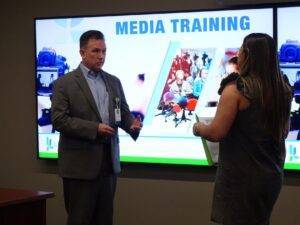 Media training is incredibly valuable for anyone who interacts with news journalists. A structured media training program helps individuals, as well as the businesses and nonprofits they represent, shine in the media.
Media training is incredibly valuable for anyone who interacts with news journalists. A structured media training program helps individuals, as well as the businesses and nonprofits they represent, shine in the media.
Organizations of all sizes benefit from media training. Larger organizations typically employ communications professionals whose responsibilities include proactive and reactive PR efforts. However, media often request interviews with individuals other than the official spokesperson. Meanwhile, smaller organizations may lack a full-time PR professional. However, they still need representatives to serve as the organization’s face and voice.
Media training is one of Priority Marketing’s signature Public Relations services. Often times, this is accomplished through a 2-hour training session. The firm’s team of experienced TV and print journalists lead training sessions for nonprofit and for-profit organizations, as well as government officials and political candidates. Priority Marketing’s other PR services include copywriting, media pitching, speech development, PowerPoint presentations, event promotion, government relations, communications strategy and more.
Below is a brief overview of media training.
Components of a Media Training Program
There are three primary components of a standard media training program: education, practice and review. Each component is equally important.
Education
It’s important to learn how media operate. That includes how reporters capture quotes and soundbites, as well as their deadlines. Each media outlet and publication have different areas of focus, like business, education or lifestyle.
Priority Marketing’s media training program prepares individuals for interviews by covering the following topics:
- Key messages: Most important to an interview is communicating the key messages that you want the readers/viewers/listeners to understand, including any calls to action.
- Presentation: From body language to what you wear, how you present yourself reflects your brand.
- Understanding media: There are several types of interview formats for various media platforms. Knowing the story goal and interview setting will help you feel prepared.
Additionally, each organization should have an internal media policy that outlines protocols for media interviews. That is an important reference point.
Practice
They say practice makes perfect. That’s certainly true with media interviews. The most polished spokespeople and CEOs have significant media experience, but they also know how to prepare.
Preparation includes reviewing key messages and points of emphasis, as well as developing a list of potential questions. Individuals should also consider the topic and environment when choosing an outfit. Props or products should be available if they’re part of the conversation.
Reporters, editors, anchors and producers conduct interviews in different types of formats:
- TV: Stand-up, sit-down, in-studio or video call
- Print: In person, by email or via telephone
- Radio: In-studio or via telephone
- Online: Video call or telephone
Practice sessions during media training consist of simulated interviews about a specific scenario. Reporters may provide a few questions in advance, but oftentimes the conversation is free-flowing and does not follow a script. Practice helps prepare for the expected and unexpected.
Review
After completing practice interviews during media training, participants have opportunities to review their own performance. Watching yourself on TV is a great way to identify potential areas for improvement.
During interview playback, Priority Marketing encourages participants to analyze whether they conveyed their full messages in a concise manner. Reporters often use soundbites of one to four sentences, so it’s important to be brief.
Another area of focus during the review is body language. Participants often are unaware of their hand gestures or posture unless they specifically look for it. Also, it’s important to smile before and after answering questions if a smile is appropriate for the topic.
Participants typically find two media relations techniques incredibly helpful in conveying their message. Both ensure the best soundbites are featured in the news:
- Bridging: Interviewees acknowledge the reporter’s question but guide their response to the key messages.
- Flagging: Interviewees use key words that alert journalists to an important fact, phrase or message.
In an introduction to its Media Training Guidebook, PRNEWS notes the importance of media training.
“It all comes down to telling the right story in the right way, even when things go wrong and the brand is under fire. There are many different paths to that goal – with obstacles along the way in each one – and it’s our aim to get you there.”
Media Training: Crisis Communications
Many organizations undergo media training, so leadership is prepared to handle a potential crisis. A crisis can be related to finances, personnel, weather, government policies, criminal activity, consumer complaints or more.
Preparation is critical in addressing a crisis, and media training helps participants prepare for tough questions. Conveying the desired message at the appropriate time can help a business or nonprofit navigate out of a tough situation. Ultimately, this can help protect the brand – now and into the future.
DOWNLOAD: Crisis Communication Game Plan
Media Training: Day-to-Day Communications
Many media interactions stem from proactive, positive PR efforts. These include story pitches and news releases about new products, services, locations or programs. In those cases, reporters will already have some basic information for their stories. They may just need a soundbite or quote to help personalize the story.
It’s also important to be prepared for these interviews. Even though the subject matter is familiar, interviewees must still communicate key messaging.
WATCH: 5 things everyone should know about PR
Media training helps clients shine. A successful interview results in positive PR, and this interaction might be the start to a strong relationship with the media that results in additional media coverage in the future.
Do you need a comprehensive media training program to strengthen your brand? Please give us a call today at 239-267-2638 or send an email to LetsTalk@PriorityMarketing.com.




